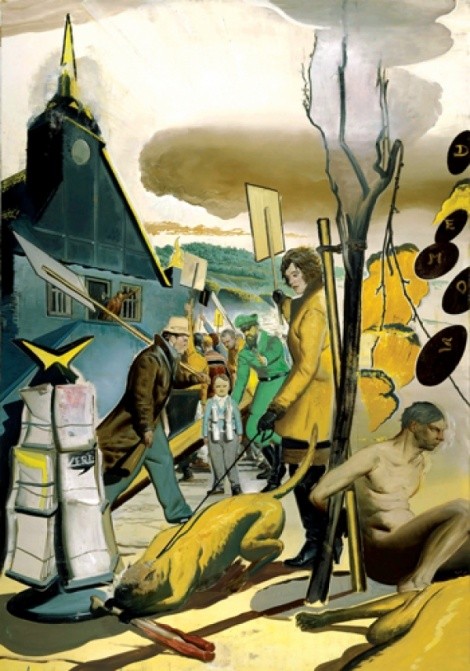
Despite being sandwiched between two high-traffic downtown gathering spots—the Salt Palace Convention Center and Abravanel Hall—the Salt Lake Art Center is largely and mysteriously an underused cultural attraction. And right now, it happens to be host to one of the most important contemporary art exhibits to come not only to Salt Lake City, but to the Western United States: Life After Death: New Leipzig Paintings From the Rubell Family Collection.
“Artists’ growth in the world is always evident,” Salt Lake Art Center Director Ric Collier says of the paintings. “They put it out there, naked, in front of everyone.”
Art is, he also asserts, often just behind or ahead of the rest of the world. Certainly these notions pertain to the New Leipzig School painters. The immediate environment of the city of Leipzig and its social climate changed dramatically in a short time in 1989; after the Berlin Wall came down, artists were free to change not only their residence but their very approach to painting.
The effect on art coming out of the Leipzig School has become especially evident over the past few years. The resulting work is intriguing conceptually and is truly confectionary to the eye—especially for those who are themselves painters. This is current work, a collection that is being acquired as it is happening right now. And as the extreme jump in its monetary value over a couple of years indicates, the work is an important contemporary grouping.
As a painter, I anticipated the exhibition weeks before its arrival and, upon viewing, knew it warranted community excitement and discussion. This exhibition has traveled around the American West for the first time, something that Don and Mera Rubell wanted to facilitate, and has effectively made paintings that were a hot topic in Europe accessible to the public on the other side of the pond. It goes without saying that this is an especially rare delight for Utah art lovers, who are usually left to view big-time contemporaries through a periscope. As Mark Coetzee, curator of the Rubell Family’s collection, says, “We wanted to make sure each community didn’t feel like a second- or third-hand thought.”
Coetzee’s comment means that with each venue the exhibition has traveled to, he and the Rubells would try to acquire a new piece. For the first time in the 43-year history of the collection, they actually purchased between 16 and 20 pieces in one day. Thanks to this ever-growing collection, Salt Lake City is only the second city in the world to see Neo Rauch’s recently completed large, tumbling fluorescent diptych Vorführung.
I was curious what it was about the New Leipzig paintings that had become so alluring to world-class collectors. Coetzee says he suspects the Rubells were captivated by the work for the same reasons that he and I, and many other viewers, probably were—the intrinsic psychological tension, the technical capabilities of the artists, and the history behind the paintings.
It’s certainly tasty stuff to be able to get up close to. The paint application, in many of the works, is quite titillating. Matthias Weischer’s lonely interiors are flatly composed of thick and peeling paint, appearing in some areas like it was applied with a trowel. The varying degree to which parts of the pieces are finished reveals and reminds that they are flat depictions of three-dimensional space, made up of paint as heavy and smooth as frosting. Pencil and charcoal drafting lines remain, and although the paintings are meticulously rendered, there seems to be relatively little concern with realistic space and form. All the work in the show displays academic knowledge of perspective and drafting, yet almost all of the paintings mix the clean, concise vanishing lines with strange figures or abstracted surfaces—in Rauch’s work, with vague yet conspicuous political overtones.
This notion particularly applies to what may have been my favorite work, Demos (Demonstrations). As the name implies, it depicts what appear to be protesters. However, all of their signs face away from the viewer, and other peculiar goings-on distract from their activity. A large dog gnaws on a giant, flesh-covered bone; the most wonderfully odd, cryptic character of the entire show is ushered by a police officer and looks you plainly in the eyes with his stiff expression and strange adornments.
Coetzee says of contemporary art that as artists and as viewers, we want to be part of the conversation relevant to our time, and to our role and context in the world. The Leipzig exhibit provides a relevant and up-to-date resource for what is happening with painting. If Salt Lake City embraces this resource, Coetzee says candidly, it will prompt shows of ever-increasing quality to come from the Rubells’ collection. After all, it took merely a suggestion to Collier by an artist and patron for this show to come here. It takes the interest of the community and its artists to support institutions like the Salt Lake Art Center. “If you don’t have time to look at work,” Collier asks, “how can you consider yourself an artist?”
LIFE AFTER DEATH: NEW LEIPZIG PAINTINGS FROM THE RUBELL FAMILY COLLECTION
Salt Lake Art Center, 20 S. West Temple, Through Sept. 28, 328-4201, SLArtCenter.org